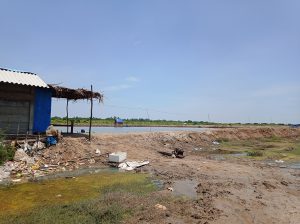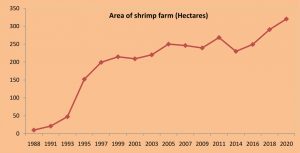Shrimp farms in the south Indian state of Tamil Nadu have proliferated despite a 1996 Supreme Court judgement to regulate coastal aquaculture
This article is by Arunkumar A.S. (arunkumar.as@ifpindia.org), post-doctoral fellow at the French Institute of Pondicherry in Puducherry; Ajit Menon (ajit1112@gmail.com), professor at the Madras Institute of Development Studies in Chennai; and Nithya K.(nithanthro@gmail.com) and Shakila H. (saishaki251998@gmail.com), former research assistants at the Madras Institute of Development Studies in Chennai
Given an option, I would move away from this village to nearby Chidambaram town because, year after year, the fertility of my agricultural land declines.” This was told to us by a lamenting farmer concerned about the expansion of shrimp farms in Pichavaram, a village situated near the backwaters and mangroves of Cuddalore district in the southern Indian state of Tamil Nadu. In the neighbouring fishing village of Thandavarayancholaganpettai (T.S. Pettai), a fisher echoed a similar sentiment when he complained about the menial jobs he undertook in the Middle East for 15 years because, as he put it, “shrimp farms had polluted the adjacent Uppanar river and the fish resources within it.”
Despite these voices, brackishwater shrimp aquaculture continues to expand and even, some would say, flourish. India’s overall shrimp exports, according to the Marine Products Export Development Authority (MPEDA), amounted to 590,275 tonnes with a value of US $4,426.19 million in 2020-21; of this total, 88 per cent comes from culture species. While aquaculture, both fresh and brackishwater, is being promoted by international organizations that support livelihoods and strengthen food and nutritional security, such as the Food and Agriculture Organization of the United Nations (FAO), shrimp aquaculture is blossoming because of its international demand and foreign exchange potential. In villages such as Pichavaram and T.S. Pettai, shrimp aquaculture is promoted with export markets in mind and with promises that aquaculture is a better option to agriculture in increasingly saline coastal ecologies.
The story of brackishwater aquaculture is, however, more complicated. Aquaculture is as much a cause of salinity as it is a solution to it. Moreover, while there are potential winners—those who have the capital to invest and the ability to take risks—there are many more losers, such as those who bear the environmental and socioeconomic consequences of degrading agricultural lands and polluted water bodies.
Looking back at Indian aquaculture
India’s tryst with aquaculture goes back to the late 1940s. After establishing fisheries stations for both inland and marine fisheries, the Indian government set up the Central Inland Fisheries Research Institute in 1959; two years later came the Central Marine Fisheries Research Institute. While the main focus was on capture fisheries, aquaculture also received attention during the Blue Revolution.
… shrimp aquaculture is promoted with export markets in mind and with promises that aquaculture is a better option to agriculture in increasingly saline coastal ecologies
Soon to follow was a National Aquaculture Development Plan aimed at improving the technical expertise in aquaculture. In 1987, the Central Institute for Brackish Water Aquaculture (CIBA) became the nodal agency for research in the sector. The Central Institute for Fresh Water Aquaculture (CIFA), a sister organization, was also established. MPEDA, charged with promoting exports, had a major role, too.
With the state significantly invested in brackishwater shrimp aquaculture, it is no surprise that it has grown since the 1980s. In 1985, the total aquaculture (fresh and brackishwater) production in India, according to FAO data, was only 0.63 million tonnes, but by 2019, it had risen to 7.8 million tonnes. It accounted for approximately half the total fish production, which had peaked at 14.2 million tonnes.
Though freshwater aquaculture still accounts for over 85 per cent of the total production, a couple of reasons explain why brackishwater aquaculture is likely to grow. Firstly, fisheries experts predict a declining availability of fish in the ocean due to ‘overfishing’. Secondly, according to CIBA, more than 80 per cent of the potential land for brackishwater aquaculture in India is unutilized, indicating the direction of future growth.
Salt of the earth
Cuddalore’s brackish water shrimp aquaculture growth story is a microcosm of India’s. In the late 1980s, aquaculture farms were established both in the north and south of the district. Penaeus monodon (tiger prawn) was the preferred species. Pichavaram and T.S. Pettai, located in the south of the district, were two of many villages in the Killai area where aquaculture expanded.
State agencies had identified Killai as a suitable site for brackish water shrimp aquaculture. A merchant from neighbouring Chidambaram town established the first shrimp farm in 1988. Many others—mostly outsiders—followed suit, triggering significant growth of shrimp aquaculture in the 1980s and 1990s. When widespread diseases struck that species in the 1990s, many non-locals sold their ponds to economically-powerful people in the villages.

Aquaculture’s growth had a cascading impact; increased salinity hit agricultural productivity, turning it unviable. People in T.S. Pettai have another factor to explain increased salinity and the expansion of aquaculture: the 2004 tsunami had a long-lasting impact on aquifers. Scientistist say the tsunami’s effect would have been short-lived, receding in the long run. This suggests that shrimp farms were most likely responsible for the sustained high levels of salinity.
Polluting with impunity
India has long witnessed the warning signs and then the adverse socioeconomic and environmental impacts of brackish water aquaculture. In the 1980s, aquaculture was mostly taken up by both foreign and Indian multinationals. Activists and many local people saw aquaculture as a form of land grab. They also highlighted how aquaculture led to environmental problems such as salinization, land degradation and water pollution.
In 1996, the Supreme Court directed the Indian government to establish a regulatory Coastal Aquaculture Authority (CAA) and ordered that no shrimp farms be constructed in coastal zones protected under the Environment Protection Act, 1986.
However, in villages such as Pichavaram and T.S. Pettai, the Supreme Court’s judgment seems a thing of the past, if at all it was ever taken seriously. Many of the licensed farms in Pichavaram and T.S. Pettai, covering an area of approximately 40 acres according to official records, are situated in ecologically sensitive areas in violation of CAA rules, either on the banks of the Uppanar river or close to the backwaters and mangroves that are supposed to be no development areas. The main aim of CAA was to ensure a precautionary approach to development on the coast. Ground reality illustrates that the approach taken is anything but precautionary.
Besides being located in prohibited areas, some farms are very close to village habitations despite CAA guidelines stipulating that farms should be minimum distance of 100 metres away from villages if the human settlement has a population of less than 500 and 300 hundred metres away if the population is more than 500. Shrimp farms are also located too close to storm water drains and do not maintain adequate spaces between ponds as is mandated, so as to contain contamination of water bodies and ground water aquifers. And perhaps most noteworthy, many farms do not have valid licenses at all. No license means no electricity connection, but this does not prevent farms from operating.
Violations galore
Pichavaram and T.S Pettai face a host of other environmental problems. Agriculture-dependent families watch crop yields decline year by year. Disadvantaged families from the Scheduled Castes such as Paraiyar and Schedule Tribes such as Irular have lost agricultural work, left with few alternatives. Those with cattle have to travel longer distances to graze the animals as both private lands and commons have come under aquaculture.
Women in Pichavaram complain about the salinity of drinking water, squarely blaming the shrimp farms. They say that the groundwater quality has deteriorated over the years as shrimp farms have expanded. Many women told us that they often have to travel up to a kilometre for drinking water in the morning; this is a real burden as that’s the time they have to ready their children for school. Some families are now buying drinking water, multiplying the stress of their threatened livelihood.
Fishers have been equally affected by the discharge of untreated effluent into the river and the backwaters. One fisher in T.S. Pettai told us that several species of fish, molluscs and crustaceans that they caught earlier in the Uppanar river are no longer available. Fishers could earlier predict the movement of species according to the tides; water pollution prevents this now.
Both Scheduled Caste men and Irular women who gleaned for shrimp say they have lost both a livelihood and an important source of protein. They now catch polychaetes, widely used in aquaculture feed. Irular women and men are almost fully dependent on this work. Commercial agents transport Irulars to the nearby backwaters of the Vellar and Kollidam basin to catch polycheates, which are then smuggled to shrimp hatcheries in the neighbouring state of Andhra Pradesh.
A wider pattern
These problems are not specific to Cuddalore. They exist throughout the coastal regions of Tamil Nadu where shrimp farms have proliferated. Take, for example, the expansion of shrimp farms in Thalaijyayiru village of Nagapattinam district. Where paddy cultivation was once dominant, effluent now pollutes arable lands. Vaippar village of Thoothukudi faces a different problem: here, shrimp farms encroach upon land allocated to Scheduled Caste cooperatives for salt production.

In a recent judgment by the National Green Tribunal (NGT), CAA was directed to demolish all illegal and unlicensed aquaculture farms operating near the Pulicat Birds Sanctuary in Thiruvallur district. Prior to this order the District Collector submitted a report which indicated that there were only 52 licensed ponds while others were all unlicensed. Given the unsuccessful attempt to regulate shrimp aquaculture and the failed history of legal remedies, one wonders what impact the NGT order will have?
Aquaculture requires substantial capital investment and the ability to take several risks
Only those with capital
While being envisaged as an alternative livelihood for small farmers especially and a solution to salinity in the coastal regions, in practice shrimp aquaculture in Tamil Nadu seems to benefit the economically and politically powerful. In Pichavaram and T.S. Pettai, most of the aquaculture farm owners are connected to powerful political parties in the state.
Aquaculture requires substantial capital investment and the ability to take several risks. The feed agency shop owner told us that it “costs almost INR 1.4 million (US$ 17,000) per hectare for one three-month cycle of shrimp culture”. This is not possible for most people, even those who now feel that shrimp farming is the only option due to high levels of salinity.
Those who can invest also depend on financial support from feed and marketing companies such as CP, Shenglong and Avanthi that also provide seed and feed and then claim the advance back post-harvest. In case of loss—quite common in shrimp aquaculture—the farm owner should be able to sustain losses and repay the dues. That is why one shrimp owner said: “Not everyone in the village can run the show.”
For more
S. Jagannath vs Union Of India & Ors on 11 December, 1996
https://indiankanoon.org/doc/507684/
Aquaculture in India : The Supreme Court Verdict
https://base.d-p-h.info/en/fiches/premierdph/fiche-premierdph-4040.html